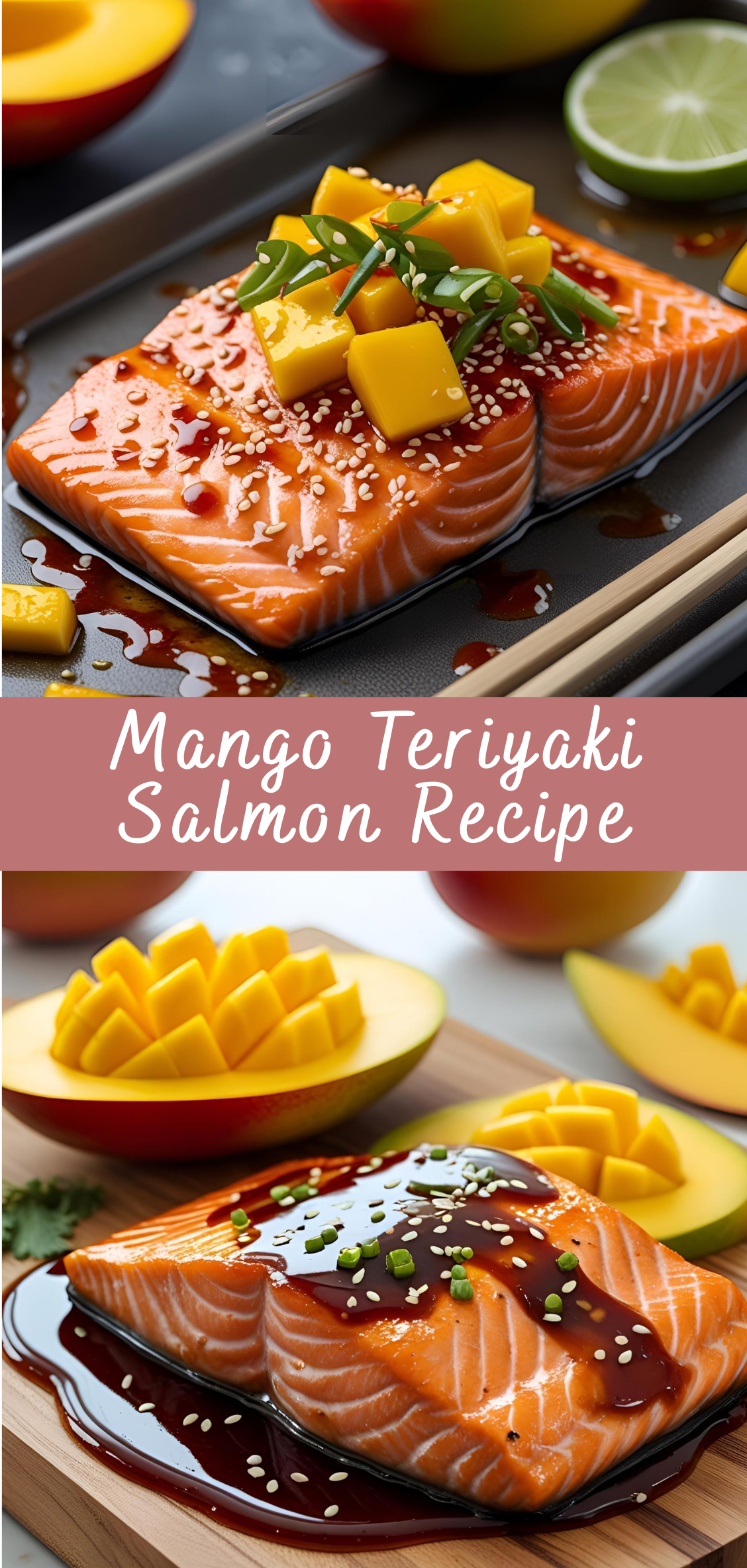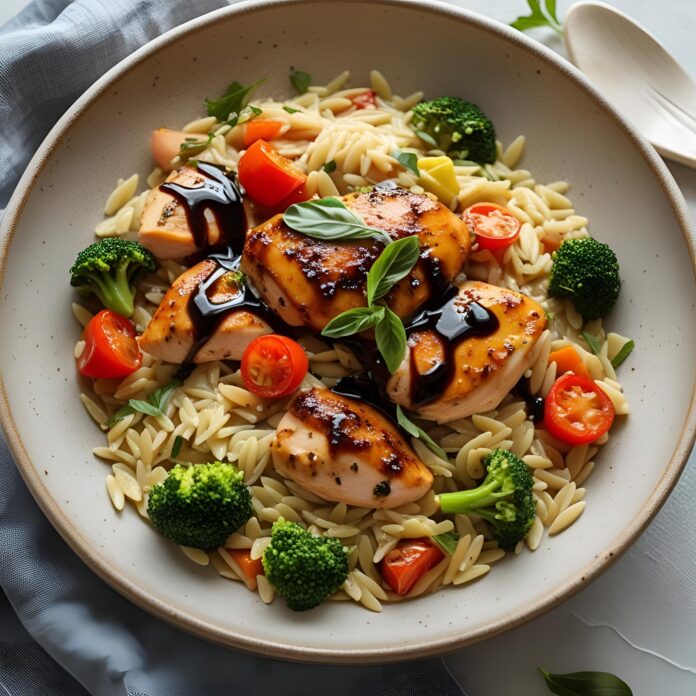Mango Teriyaki Salmon Recipe
Salmon is a culinary favorite around the world—not just for its rich, buttery flavor and firm texture, but also for its versatility in the kitchen. From sashimi to smoked, grilled to roasted, the ways in which salmon can be enjoyed are as varied as the cultures that embrace it. Among these, one preparation that has gained popularity for its unique fusion of flavors is Mango Teriyaki Salmon. Combining the succulent, flaky qualities of fresh salmon with the vibrant sweetness of ripe mango and the deep umami of teriyaki glaze, this dish offers a refreshing take on seafood cuisine that appeals to both seasoned home cooks and casual food enthusiasts alike.
The inspiration behind Mango Teriyaki Salmon comes from a growing global interest in fusing traditional Asian cooking techniques with bold tropical ingredients. Teriyaki sauce, with its roots in Japanese cuisine, is a time-honored glaze made from soy sauce, mirin, sugar, and sake. It’s revered for its glossy finish and complex flavor profile that delicately balances sweet and salty. Pairing this with mango—a fruit native to South Asia but celebrated globally for its juicy sweetness—brings an exciting tropical twist that elevates the entire dish. The result is a symphony of flavors where the caramelized edges of seared salmon meet the fruit-forward zing of mango puree, all brought together under a savory glaze that ties every element into one cohesive experience.
What makes this recipe particularly appealing is its adaptability. It can be served in an elegant plated dinner with coconut rice and stir-fried vegetables, or as a casual weeknight meal over a fresh mango slaw. It’s equally suited for a summer dinner party or a cozy winter meal. Furthermore, this dish isn’t just about bold flavor; it’s also rooted in nutrition. Salmon is a rich source of omega-3 fatty acids, high-quality protein, and essential vitamins like B12 and D. When paired with fresh mangoes—packed with vitamin C, fiber, and antioxidants—it becomes a health-conscious choice that doesn’t compromise on taste or presentation.
The art of creating Mango Teriyaki Salmon lies in striking the right balance. Go too heavy on the mango, and you risk overpowering the subtle flavor of the fish. Skimp on the teriyaki elements, and the dish may lack depth and contrast. Through precise measurements, thoughtful marination, and careful cooking techniques, this recipe aims to guide you step-by-step through the process of achieving that ideal balance. Whether you’re cooking for yourself, your family, or guests, you’ll find that this dish offers not just satisfaction, but also a sense of accomplishment.
This recipe guide doesn’t simply list ingredients and cooking steps—it delves into the story, science, and strategy behind each component. From choosing the best cut of salmon to selecting the right ripeness of mango, from making your own teriyaki glaze at home to achieving the perfect sear on your fillet, this comprehensive guide is designed to teach, inspire, and transform the way you cook salmon. Even if you’ve never made a fusion seafood dish before, this walkthrough will provide you with the confidence and clarity to succeed.
Beyond the plate, Mango Teriyaki Salmon symbolizes something more—it embodies culinary creativity and cultural blending. It encourages exploration and experimentation. It reminds us that the kitchen is not just a place for routine meals, but also a canvas for artistry and innovation. By choosing to make this recipe, you’re not only preparing a meal, you’re engaging with a vibrant, evolving food culture that celebrates both tradition and novelty.
In the sections to come, we’ll dive deeper into every aspect of the dish. We’ll begin by breaking down the key ingredients—discussing why they matter, how to select them, and how they interact. From there, we’ll move on to preparation methods, marinating tips, cooking techniques, and plating ideas. We’ll also include variations for different dietary preferences, expert tips to elevate your results, and suggestions for side dishes and beverages that pair perfectly with Mango Teriyaki Salmon.
So, whether you’re looking to impress guests with a restaurant-quality dish or simply treat yourself to something extraordinary, this Mango Teriyaki Salmon recipe is your guide to a delicious, nourishing, and memorable meal.
Detailed Instructions: How to Make Mango Teriyaki Salmon
Creating the perfect Mango Teriyaki Salmon involves several distinct stages: preparing the mango teriyaki sauce, marinating the salmon, cooking the fillets, and finally assembling and serving the dish. Each stage contributes to the flavor, texture, and overall experience. Let’s explore each step in detail.
1. Preparing the Mango Teriyaki Sauce
The sauce is the heart of this dish. It’s a marriage of savory and sweet elements that complement, rather than overpower, the salmon. Unlike traditional teriyaki sauce which relies solely on sugar and mirin for sweetness, this version incorporates ripe mango to create a fresher, fruitier dimension.
Ingredients for the Sauce:
-
1 large ripe mango, peeled and cubed
-
1/3 cup soy sauce (low sodium recommended)
-
2 tablespoons rice vinegar
-
2 tablespoons brown sugar (adjust to taste)
-
1 tablespoon honey or maple syrup (optional, for extra sweetness)
-
2 tablespoons mirin (Japanese sweet rice wine)
-
1 tablespoon freshly grated ginger
-
2 cloves garlic, minced
-
1/2 teaspoon sesame oil
-
1/4 teaspoon crushed red pepper flakes (optional, for mild heat)
-
1 teaspoon cornstarch mixed with 1 tablespoon cold water (slurry)
Instructions:
-
Blend the Mango Base:
-
Place the peeled and chopped mango into a blender or food processor. Blend until smooth. You should end up with about 3/4 to 1 cup of mango puree, depending on the size of the mango.
-
-
Combine Sauce Ingredients:
-
In a medium saucepan over medium heat, combine the mango puree, soy sauce, rice vinegar, brown sugar, honey (if using), mirin, grated ginger, minced garlic, sesame oil, and red pepper flakes.
-
Stir to combine thoroughly and bring to a gentle simmer.
-
-
Thicken the Sauce:
-
Once the sauce is simmering, stir in the cornstarch slurry while whisking continuously.
-
Continue simmering for 3–5 minutes, or until the sauce has thickened to a glossy, pourable consistency. It should coat the back of a spoon.
-
-
Taste and Adjust:
-
Taste the sauce. Add more soy sauce if it’s too sweet, more brown sugar or mango if it’s too salty, or a splash of lime juice for acidity.
-
Once satisfied, remove from heat and let it cool to room temperature.
-
-
Reserve and Store:
-
Set aside 1/2 cup of the sauce for marinating. Store the remaining sauce in an airtight jar in the refrigerator; it can be used for glazing during cooking or drizzling before serving.
-
2. Marinating the Salmon
Marinating is essential for flavor infusion. The acids and sugars in the sauce begin to tenderize the fish and infuse it with subtle flavor notes. However, because salmon is delicate, it should not be over-marinated.
Ingredients for This Step:
-
4 salmon fillets (about 6 ounces each), skin-on or skinless
-
Reserved 1/2 cup mango teriyaki sauce
-
1 tablespoon olive oil (optional, to prevent sticking if grilling or baking)
Instructions:
-
Pat Salmon Dry:
-
Use paper towels to gently blot excess moisture from the salmon fillets. This step is crucial for helping the marinade adhere and for achieving a better sear later.
-
-
Marinate:
-
Place the salmon fillets in a shallow dish or a zip-top bag. Pour the 1/2 cup reserved mango teriyaki sauce over the fish.
-
Ensure all surfaces are coated evenly. If using a dish, flip the fillets once to coat both sides.
-
Cover or seal and refrigerate for 20 to 30 minutes. Avoid marinating longer than 1 hour, as the acidity can begin to “cook” the fish.
-
-
Remove and Rest:
-
Remove the salmon from the marinade and allow it to rest at room temperature for 10 minutes before cooking. Discard any remaining marinade that touched raw fish.
-
3. Cooking the Salmon
There are several methods you can use to cook your salmon—pan-searing, baking, or grilling. Each method brings out different textures and flavors. This recipe offers all three, so you can choose based on preference or convenience.
Option 1: Pan-Searing (Recommended for Maximum Flavor and Texture)
Pan-searing gives the salmon a beautifully crisp exterior and a tender, juicy interior.
Instructions:
-
Heat a large non-stick or cast-iron skillet over medium-high heat.
-
Add 1 tablespoon of neutral oil (such as canola or avocado oil).
-
Once hot, carefully place the salmon fillets in the pan, skin-side down if skin is on.
-
Sear for 4–5 minutes, undisturbed, until the skin is crisp and the flesh is mostly opaque.
-
Flip carefully and cook for an additional 2–3 minutes on the other side.
-
For extra flavor, brush a little reserved mango teriyaki sauce on top of each fillet during the last minute of cooking.
-
Remove from pan and let rest for 2–3 minutes before serving.
Option 2: Baking (Best for Set-It-and-Forget-It Cooking)
Baking is convenient, especially for larger batches, and ensures even cooking without much attention.
Instructions:
-
Preheat your oven to 400°F (200°C).
-
Line a baking tray with parchment paper or lightly oil it.
-
Place marinated salmon fillets on the tray, skin-side down.
-
Brush with additional mango teriyaki glaze.
-
Bake for 12–15 minutes, depending on thickness, or until the fish flakes easily with a fork.
-
Optionally broil on high for 2 minutes at the end to caramelize the glaze.
Option 3: Grilling (Ideal for Summer and Outdoor Cooking)
Grilling adds a smoky dimension and is a crowd-pleaser at outdoor gatherings.
Instructions:
-
Preheat grill to medium-high and oil the grates well.
-
Place salmon skin-side down on the grill.
-
Grill for 4–5 minutes, then flip and grill for another 2–4 minutes.
-
Baste with extra mango teriyaki glaze during the last minute for a glossy finish.
-
Use a fish spatula for flipping to prevent tearing.
4. Finishing Touches and Serving
Once your salmon is cooked, it’s time to bring the dish together. Presentation is part of the dining experience, and a few final touches can turn this from a simple dish into a restaurant-worthy plate.
Plating Suggestions:
-
Serve salmon over a bed of jasmine rice, coconut rice, or quinoa.
-
Drizzle extra warm mango teriyaki sauce over the top.
-
Garnish with thinly sliced green onions, sesame seeds, or fresh mango cubes.
-
Add a wedge of lime or a sprinkle of chopped cilantro for freshness.
Serving Ideas:
-
With Sides: Roasted broccolini, sesame snap peas, or grilled pineapple make excellent sides.
-
As a Bowl: Try a “Mango Teriyaki Salmon Bowl” with rice, avocado, shredded carrots, cucumbers, edamame, and a drizzle of sauce.
-
As Tacos: Flake the salmon and serve in corn tortillas with mango salsa and cabbage slaw for a tropical fusion taco night.
Mango Teriyaki Salmon Recipe
Salmon is a culinary favorite around the world—not just for its rich, buttery flavor and firm texture, but also for its versatility in the kitchen. From sashimi to smoked, grilled to roasted, the ways in which salmon can be enjoyed are as varied as the cultures that embrace it. Among these, one preparation that has gained popularity for its unique fusion of flavors is Mango Teriyaki Salmon. Combining the succulent, flaky qualities of fresh salmon with the vibrant sweetness of ripe mango and the deep umami of teriyaki glaze, this dish offers a refreshing take on seafood cuisine that appeals to both seasoned home cooks and casual food enthusiasts alike.
Ingredients
- For the Mango Teriyaki Sauce:
- 1 ripe mango, peeled and chopped
- 1/4 cup low-sodium soy sauce
- 2 tbsp honey (or maple syrup)
- 1 tbsp rice vinegar
- 1 tbsp sesame oil
- 2 garlic cloves, minced
- 1 tsp fresh ginger, grated
- 1 tsp cornstarch + 1 tbsp water (slurry, optional for thickening)
- For the Salmon:
- 4 salmon fillets (about 6 oz each)
- Salt and pepper, to taste
- 1 tbsp olive oil (for searing)
- Sesame seeds and green onions (for garnish)
Instructions
1. Make the Mango Teriyaki Sauce:
- In a blender, combine mango, soy sauce, honey, rice vinegar, sesame oil, garlic, and ginger.
- Blend until smooth.
- Pour into a small saucepan and heat over medium.
- If desired, stir in cornstarch slurry to thicken the sauce.
- Simmer 3–5 minutes, stirring often. Remove from heat and set aside.
2. Prepare the Salmon:
- Pat salmon dry with paper towels.
- Season lightly with salt and pepper.
- Heat olive oil in a large nonstick or cast-iron skillet over medium-high heat.
- Add salmon, skin-side down (if using skin-on), and sear 4–5 minutes.
- Flip and cook another 3–4 minutes, or until cooked to desired doneness.
3. Glaze and Serve:
- Brush cooked salmon with mango teriyaki sauce.
- Garnish with sesame seeds and chopped green onions.
- Serve over rice, quinoa, or sautéed vegetables.
Notes
- Fresh vs Frozen Mango: Fresh mango gives the best flavor, but thawed frozen mango works well too.
- Oven Option: Bake salmon at 400°F (200°C) for 12–15 minutes instead of pan-searing, if preferred.
- Make it Spicy: Add a dash of sriracha or red pepper flakes to the sauce for heat.


